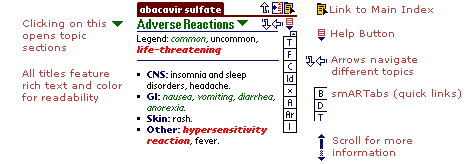 |
|
|
|
I don’t know about you, but my PDA never leaves my side and the application I use most frequently is my drug guide. Whether I am in the hospital, in the field, answering student’s questions, or getting phone calls from neighbors and relatives, an up-to-date drug guide is an invaluable tool for any healthcare professional.
RnNDH is a PDA program based on the print version on Nursing 2004 Drug Handbook from Lippincott Williams & Wilkins (LWW). We all certainly have come to know and respect the Nursing Drug Handbook.
Installation and Memory Requirements RnNDH is another program available in the Skyscape format for the Palm OS and the Pocket PC. I found it very easy to load this application onto my Palm m515. As with other Skyscape products, the program loads without much effort or thinking on my part. This is so important for those of us who are novices. Part of the program automatically loads to my memory card, saving much needed space on my Palm. Skyscape lists the RnNDH as needing 3.8MB on the Palm. When I checked info on my Palm it said the application on the Handheld was 204K with the balance of the 3.8MB residing on the expansion card. The Pocket PC requires 8.1MB. Ease of Use & Navigation RnNDH has three indices: Main index which has generic names and medical conditions listed; Trade names index; and a Table of Contents. Once you have chosen a drug from either the main index or the trade name index you will be able to get information on that drug in the following categories:
I liked the category of Effect on lab test results, which I had not seen in another drug program. The Classification category identifies the chapter in the textbook which would be helpful to students who are using that text in their pharmacology course. What I found unique about RnNDH were the interesting appendices. The Herbal medicines category is certainly necessary in today’s healthcare environment. Under each herb is information on the other names, its uses, nursing considerations and teaching. There is an infusion rate appendix which identifies infusion rates for emergency drugs such as nitroglycerine and dopamine in addition to others. Other appendices include Therapeutic drug monitoring; Selected local and topical anesthetics; Diagnostic skin tests; Selected drugs used for conscious sedation; Normal laboratory test values; Dialyzable drugs; and Drugs that shouldn’t be crushed.
Skyscape Product Intereface (Palm OS) RnNDH (Nursing Drug Handbook)
I also liked the color and font coding under adverse reactions as seen above. The life threatening, uncommon and common reactions are easily identified, making it easier to interpret when so many drugs seem to have a never-ending list of adverse reactions.
Inter-Operability With Skyscape's patented smARTlink technology, RnNDH also allows me to link with other Skyscape products when researching a topic. For example, if I look up the drug prednisone and see that it is given for asthma, I can then link to other programs I have installed like Taber's (Cyclopedic Medical Dictionary) and RNDiseases (Diseases and Disorders: A Nursing Therapeutics Manual) and get additional information on asthma. I can effortlessly change back and forth between applications with the Skyscape technology.
The Downside I would suggest changing the indices for this program. I would like to see a main index that only deals with the drugs rather than including diseases. And, I would like to see trade and generic drugs in the same index. I find it cumbersome to have to decide if this is the trade name or the generic name and then choose the appropriate index. For beginning nursing students this would be a problem, since they may not know if the name was generic or trade. These indices have slowed down my research for drugs. I never was able to find the recommended use and dosage for epinephrine in a cardiac arrest. Value The program is selling for $44.95 which certainly makes it competitive with other drug handbooks which are selling for $41.95-$49.95. The cost of the program also includes a year of quarterly updates, certainly an important selling point with pharmacology changing so rapidly. The nurses I work with always know to look for me when they can’t find a new drug in their text. I can always find it in my PDA. The textbook upon which this program is based sells for $37.95. I continue to believe that programs should be the same price as the books. Summary and Recommendation A drug program is the first program any nurse should purchase upon buying a PDA. RnNDH is a good choice for that drug program and with some changes could be a great program.
Cindy can be reach via e-mail RnNDH (Nursing Drug Handbook) for the Palm
OS and the Pocket
PC
|
|||||||||


